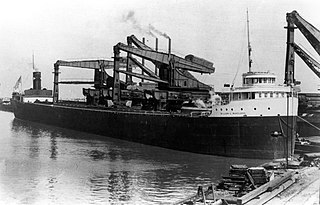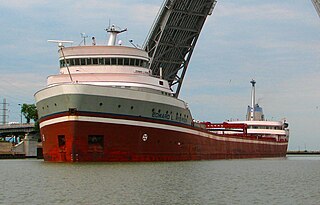
SS Edmund Fitzgerald was an American Great Lakes freighter that sank in Lake Superior during a storm on November 10, 1975, with the loss of the entire crew of 29 men. When launched on June 7, 1958, she was the largest ship on North America's Great Lakes, and she remains the largest to have sunk there. She was located in deep water on November 14, 1975, by a U.S. Navy aircraft detecting magnetic anomalies, and found soon afterwards to be in two large pieces.

The SS William G. Mather is a retired Great Lakes bulk freighter now restored as a museum ship in Cleveland, Ohio, one of five in the Great Lakes region. She transported cargo such as ore, coal, stone, and grain to ports throughout the Great Lakes, and was nicknamed "The Ship That Built Cleveland" because Cleveland's steel mills were a frequent destination.

Lake freighters, or lakers, are bulk carrier vessels that operate on the Great Lakes of North America. These vessels are traditionally called boats, although classified as ships.

SS William Clay Ford was a bulk freighter built for hauling material on the Great Lakes. She was named for William Clay Ford Sr., grandson of Henry Ford. Her keel was laid in 1952 at River Rouge, Michigan by the Great Lakes Engineering Works, and she was launched in 1953. The ship was a part of the Ford Motor Company fleet of ore carriers and made her home port at Ford's River Rouge Plant, south of Detroit, Michigan. The first captain of William Clay Ford was John Jameson Pearce of Dearborn, Michigan.
SS Cotopaxi was an Emergency Fleet Corporation (EFC) Design 1060 bulk carrier built for the United States Shipping Board (USSB) under the World War I emergency shipbuilding program. The ship, launched 15 November 1918, was named after the Cotopaxi stratovolcano of Ecuador. The ship arrived in Boston, 22 December 1918, to begin operations for the USSB, through 23 December 1919, when Cotopaxi was delivered to the Clinchfield Navigation Company under terms of sale.

SS Daniel J. Morrell was a 603-foot (184 m) Great Lakes freighter that broke up in a strong storm on Lake Huron on 29 November 1966, taking with her 28 of her 29 crewmen. The freighter was used to carry bulk cargoes such as iron ore but was running with only ballast when the 60-year-old ship sank.

The Dry Dock Complex consists of six interconnected buildings located at 1801–1803 Atwater Street in Detroit, Michigan, as well as the remains of a nearby dry dock at 1900 Atwater Street. The 1801-1803 Atwater complex is also known as the Globe Trading Company Building, and in 2015 was opened by the Michigan Department of Natural Resources as the Outdoor Adventure Center.

SS Cedarville was a bulk carrier that carried limestone on the Great Lakes in the mid-20th century until it sank after a collision with another ship, MV Topdalsfjord May 7 1965
The American Ship Building Company was the dominant shipbuilder on the Great Lakes before the Second World War. It started as Cleveland Shipbuilding in Cleveland, Ohio in 1888 and opened the yard in Lorain, Ohio in 1898. It changed its name to the American Ship Building Company in 1900, when it acquired Superior Shipbuilding, in Superior, Wisconsin; Toledo Shipbuilding, in Toledo, Ohio; and West Bay Shipbuilding, in West Bay City, Michigan. With the coming of World War I, the company also acquired Buffalo Dry Dock, in Buffalo, New York; Chicago Shipbuilding, in Chicago, Illinois; and Detroit Shipbuilding, in Wyandotte, Michigan. American Shipbuilding ranked 81st among United States corporations in the value of World War II military production contracts.

The SS St. Marys Challenger is a freight-carrying vessel operating on the North American Great Lakes built in 1906. Originally an ore boat, she spent most of her career as a cement carrier when much larger ore boats became common. After a 107-year-long working career as a self-propelled boat, she was converted into a barge and paired with the tug Prentiss Brown as an articulated tug-barge. Before conversion, she was the oldest operating self-propelled lake freighter on the Great Lakes, as well as being one of the last freight-carrying vessels on the Great Lakes to be powered by steam engines.
The Type L6 ship is a United States Maritime Administration (MARAD) designation for World War II as a Great Lakes dry break bulk cargo ship. The L-Type Great Lakes Dry Bulk Cargo Ships were built in 1943 to carry much-needed iron ore from the upper Great Lakes to the steel and iron production facilities on Lakes Erie and Ontario in support of the war effort. The ships have a 15,675 tonne deadweight tonnage. The L6 ships were built by two companies: American Ship Building Company, in the case of the type L6-S-A1 models, of which 6 were built; and Great Lakes Engineering Works, Ashtabula, Ohio/ Great Lakes Engineering Works, River Rouge, Ohio, in the case of the type L6-S-B1, which produced 10 ships. Steel supply needed for World War was great. To supply iron ore from Lake Superior to steel foundries, the United States Commission had a series of L6 Lakers ship built. The Maritime Commission ordered ten Great Lakes Bulk Carriers of the L6-S-B1 type. The L6-S-B1 was design with a 3-cylinder triple expansion steam engines. The L6-S-A1 used a lentz 4-cylinder compound engine. All L6 ships were coal burning and delivered between May and November 1943. L6-S-B1 was built for the US Maritime Commission under USMC contract MCc-1834 in 1943 at the River Rouge yard. Each L6 ship cost $2.265 million. The first L6-S-B1 was the SS Adirondack/Richard J. Reiss, hull 290, keel was laid on March 9, 1942 and launched on September 19, 1942. The ships are often called the Class Lake Bulk Freighter now.

SS William C. Moreland was a 600-foot (180 m) long Great Lakes freighter that ran aground on Sawtooth Reef, Lake Superior on 18 October 1910, only a month after entering service. Visibility was poor due to the smoke from several forest fires, causing the William C. Moreland to ran full steam onto a reef. There were many attempts to salvage the ship, but eventually only the 278-foot (85 m) long stern was salvaged and was used to build the 580-foot (180 m) long Sir Trevor Dawson.

The SS William G. Mather was a 533-foot (162 m) long Great Lakes freighter that was built in 1905, by the Great Lakes Engineering Works (GLEW) of Ecorse, Michigan, for the Grand Island Steamship Company. Her keel was laid on May 18, 1905. She was launched on September 23, 1905, as hull #9. The ship was named after William G. Mather, the Cleveland-Cliffs executive. She was powered by a 2,000-horsepower (1,500 kW) triple expansion steam engine which was attached to a single fixed-pitch propeller. She was fueled by two coal-fired Scotch marine boilers.

SS Willis L. King was a 600-foot-long (180 m), steel-hulled, propeller-driven American Great Lakes freighter built in 1911 by the Great Lakes Engineering Works of Ecorse, Michigan. She was scrapped in 1984 in Ashtabula, Ohio. Willis L. King is best known for her collision with the steamer Superior City on August 20, 1920, in Whitefish Bay.

SS Edward L. Ryerson is a steel-hulled American Great Lakes freighter that entered service in 1960. Built between April 1959 and January 1960 for the Inland Steel Company, she was the third of the thirteen so-called 730-class of lake freighters, each of which shared the unofficial title of "Queen of the Lakes" because of their record-breaking length. She was not only the last steam-powered freighter built on the lakes but also the last one that was not a self-unloader. Since 2009, she has been in long-term layup in Superior, Wisconsin. She is one of only two American-owned straight deck lake freighters, the other being John Sherwin, built in 1958.

The SS Alpena is a lake freighter. She was built in 1942 by the Great Lakes Engineering Works in Ecorse, Michigan, to carry iron ore. She was originally owned by the Pittsburgh Steamship Company, a subsidiary of United States Steel. After also hauling grain in addition to ore in the 1960s and 1970s, the ship was put into storage in 1982.

SS Chester A. Congdon was a steel-hulled American lake freighter in service between 1907 and 1918. She was built in 1907 by the Chicago Shipbuilding Company of South Chicago, Illinois, for the Holmes Steamship Company, and was intended to be used in the grain trade on the Great Lakes. She entered service on September 19, 1907, when she made her maiden voyage. In 1911, Salt Lake City was sold to the Acme Transit Company. A year later, she was transferred to the Continental Steamship Company, and was renamed Chester A. Congdon, after lawyer and entrepreneur Chester Adgate Congdon. She was involved in several accidents throughout her career.
Overlakes Freight Corporation was shipping agent company founded in New York City on April 21, 1932, by William M. Nicholson. Overlakes Freight Corporation operated Liberty Ships during and for post World War II efforts. Most of Overlakes Freight Corporation ships were purchased by the War Shipping Administration for the war. Nicholson also owned the Nicholson Universal Steamship Company, Nicholson, Erie, Dover, Ferry Line, Nicholson Terminal & Dock Company, Aqua Terminal & Dock Corporation and the Nicholson Transit Company.














